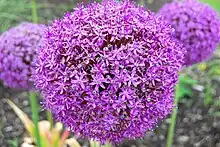Allium giganteum
Allium giganteum, common name giant onion, is an Asian species of onion, native to central and southwestern Asia but cultivated in many countries as a flowering garden plant.[4][5] It is the tallest species of Allium in common cultivation, growing to 1.5 metres (4.9 ft).[6]
| Giant onion | |
|---|---|
 | |
| Scientific classification | |
| Kingdom: | Plantae |
| Clade: | Tracheophytes |
| Clade: | Angiosperms |
| Clade: | Monocots |
| Order: | Asparagales |
| Family: | Amaryllidaceae |
| Subfamily: | Allioideae |
| Genus: | Allium |
| Species: | A. giganteum |
| Binomial name | |
| Allium giganteum | |
| Synonyms[2][3] | |
|
Allium procerum Trautv. ex Regel | |
In early to midsummer, small globes of intense purple umbels appear, followed by attractive fruiting umbels. A popular cultivar, 'Globemaster', is shorter (80 centimetres (31 in)) but produces much larger, deep violet, umbels (15–20 centimetres (5.9–7.9 in)). Both varieties have been granted the Royal Horticultural Society's Award of Garden Merit.[7][8][9]
In nature, the species is found in Iran, Afghanistan, Turkey, Turkmenistan, Tajikistan, and Uzbekistan.[3] In cultivation in the US, it performs well in USDA hardiness zones 6–10.[10]
Eating flowers, seeds, leaves, and stems can cause nausea, vomiting, and diarrhea due to the sulfides they contain.[11]
.jpg.webp) Flower opening
Flower opening Flower fully open
Flower fully open
References
- Eduard August von Regel. 1883. Gartenflora 32: 91.
- The Plant List
- Kew World Checklist of Selected Plant Families
- Regel, Eduard August von 1883. Gartenflora (1883) 32: 91
- Tropicos, Allium giganteum Regel
- Missouri Botanical Garden: Allium giganteum
- "Allium giganteum Royal Horticultural Society". Archived from the original on 2014-03-26. Retrieved 2012-06-13.
- "Allium 'Globemaster' Royal Horticultural Society". Archived from the original on 2014-03-26. Retrieved 2012-06-13.
- "Allium giganteum". Plants for a Future.
- "Allium giganteum (Ornamental Onion)". Gardenia.net. Retrieved 2021-07-09.
- "Allium giganteum (Giant Ornamental Onion, Ornamental Onion) | North Carolina Extension Gardener Plant Toolbox". plants.ces.ncsu.edu. Retrieved 2021-07-09.